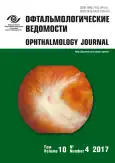Патология слёзных органов у пациентов со злокачественными опухолями щитовидной железы после терапии радиоактивным йодом и методы её коррекции
- Авторы: Белдовская Н.Ю.1, Карпищенко С.А.1, Баранская С.В.1, Карпов А.А.1
-
Учреждения:
- ФГБОУ ВО «ПСПбГМУ им. И.П. Павлова» Минздрава России
- Выпуск: Том 10, № 4 (2017)
- Страницы: 13-17
- Раздел: Статьи
- URL: https://journals.rcsi.science/ov/article/view/7783
- DOI: https://doi.org/10.17816/OV10413-17
- ID: 7783
Цитировать
Аннотация
Введение. В современном мире терапия радиоактивным йодом после тиреоидэктомии является стандартом лечения дифференцированного рака щитовидной железы. Общие дозозависимые побочные эффекты, описанные в литературе, включают в себя сиаладенит, ксеростомию, потерю вкуса и/или запаха, отёчность окружающих тканей. Об офтальмологических осложнениях сообщается редко.
Цель — оценить состояние слёзных органов у пациентов, подвергшихся терапии радиоактивным йодом по поводу рака щитовидной железы. Материал и методы. В исследование вошли 17 человек (34 глаза). Пациенты — женщины в возрасте от 19 до 43 лет (средний возраст — 31 год), перенёсшие курс радиойодтерапии по поводу рака щитовидной железы. Все они предъявляли жалобы (в сроки от 2 месяцев до 1 года после курса терапии) на периодическое или постоянное слезотечение. У 4 пациентов отмечалось постоянное или периодическое слизисто-гнойное отделяемое при надавливании на область слёзного мешка. Всем им проводилось стандартное офтальмологическое обследование: визометрия, биомикроскопия переднего отрезка, офтальмоскопия; пробы на слезопродукцию. Для диагностики нарушений слезоотведения выполнялись цветная слёзно-носовая и канальцевая пробы, проба с промыванием слёзных путей и, при необходимости, конусно-лучевая компьютерная томография с предварительным контрастированием слезоотводящих путей.
Результаты. Нарушения слезопродукции выявлялись на 20 глазах (58,8 %): из них в 3 случаях в виде синдрома «сухого глаза» средней степени; нарушения слезоотведения (непроходимость, стеноз носо-слёзного канала и хронический гнойный дакриоцистит) были отмечены в 14 глазах (41,2 %). Пациентам с патологией слезопродукции назначались слезозаменители, а в двух случаях была выполнена лазерная коагуляция слёзных точек; при нарушениях оттока слезы выполнялась эндоскопическая эндоназальная лазерная дакриоцисториностомия.
Заключение. Использование радиоактивного йода в дозах более 80 мКи ведёт к возникновению патологии слёзных органов: развитию синдрома «сухого глаза» различной степени выраженности и нарушению слезоотведения. Патология слёзных органов значительно ухудшает качество жизни пациента, поэтому профилактика этих заболеваний до проведения курса радиойодтерапии становится неотложной проблемой, требующей своего решения.
Полный текст
Открыть статью на сайте журналаОб авторах
Наталия Юрьевна Белдовская
ФГБОУ ВО «ПСПбГМУ им. И.П. Павлова» Минздрава России
Автор, ответственный за переписку.
Email: beldovskay@mail.ru
канд. мед. наук, доцент кафедры офтальмологии
Россия, Санкт-ПетербургСергей Анатольевич Карпищенко
ФГБОУ ВО «ПСПбГМУ им. И.П. Павлова» Минздрава России
Email: karpischenkos@mail.ru
д-р мед. наук, профессор, заведующий кафедрой оториноларингологии с клиникой
Россия, Санкт-ПетербургСветлана Валерьевна Баранская
ФГБОУ ВО «ПСПбГМУ им. И.П. Павлова» Минздрава России
Email: sv-v-b@yandex.ru
очный аспирант кафедры оториноларингологии с клиникой
Россия, Санкт-ПетербургАртемий Алексеевич Карпов
ФГБОУ ВО «ПСПбГМУ им. И.П. Павлова» Минздрава России
Email: artemiykarpov@mail.ru
клинический ординатор кафедры оториноларингологии с клиникой
Россия, Санкт-ПетербургСписок литературы
- Белдовская Н.Ю., Карпищенко С.А., Баранская С.В., Куликова О.А. К вопросу о неудачных исходах лазерной эндоназальной дакриоцисториностомии // Офтальмологические ведомости. – 2016. – Т. 9. – № 2. – С. 14–18. [Beldovskaya NYu, Karpishchenko CA, Baranskaya SV, Kulikova OA. About endonasal laser dacryocystorhinostomy unfavo rable outcomes. Ophthalmology Journal. 2016;9(2):14-18. (In Russ.)]. doi: 10.17816/OV9214-18.
- Валдина Е.А. Заболевания щитовидной железы. Руководство. – СПб.: Питер, 2005. – 368 с. [Valdina EA. Zabolevanija shhitovidnoj zhelezy. Rukovodstvo. Saint Petersburg: Piter; 2005. 368 p. (In Russ.)]
- Давыдов М.И., Аксель Е.М. Статистика злокачественных новообразований в России и странах СНГ в 2005 г. // Вестник РОНЦ им. Блохина РАМН. – 2007. – № 2 (Прил.). [Davydov MI, Aksel’ EM. Statistika zlokachestvennyh novoobrazovanij v Rossii i stranah SNG v 2005. Vestnik RONC im. Blohina RAMN. 2007;(2)(Appl.). (In Russ.)]
- Karpischenko SA, Baranskaya SV. Our experience in intranasal laser endoscopic dacryocystorhinostomy. Folia Otorhinolaryngologiae et Pathologiae Respiratoriae. 2016;22(3): 32-35.
- Alexander C, Bader JB, Schaefer A, et al. Intermediate and long-term side effects of high-dose radioiodine therapy for thyroid carcinoma. J Nucl Med. 1998;39(9):1551-4.
- Al-Qahtani KH, Al Asiri M, Tunio MA, et al. Nasolacrimal duct obstruction following radioactive iodine 131 therapy in differentiated thyroid cancers: review of 19 cases. Clin Ophthalmol Auckl NZ. 2014;8:2479-2484. doi: 10.2147/OPTH.S71708.
- Fard-Esfahani A, Emami-Ardekani A, Fallahi B, et al. Adverse effects of radioactive iodine-131 treatment for differentiated thyroid carcinoma. Nucl Med Commun. 2014Aug;35(8):808-817. doi: 10.2147/OPTH.S71708.
- Fard-Esfahani A, Mirshekarpour H, Fallahi B, et al. The effect of high-dose radioiodine treatment on lacrimal gland function in patients with differentiated thyroid carcinoma. Clin Nucl Med. 2007;32(9):696-9.
- Kim J, Cho SG, Kang SR, et al. Preparation for radioactive iodine therapy is not a risk factor for the development of hyponatremia in thyroid cancer patients. Medicine (Baltimore). 2017Feb;96(5): e6004. doi: 10.1097/MD.0000000000006004.
- Patel SS, Goldfarb M. Well-differentiated thyroid carcinoma: the role of post-operative radioactive iodine administration. J Surg Oncol. 2013;107(6):665-672.
- Savage MW, Sobel RK, Hoffman HT, et al. Salivary gland dysfunction and nasolacrimal duct obstruction: stenotic changes following I-131 therapy. Ophthal Plast Reconstr Surg. 2015Jun;31(3): e50-52.
- Van Tassel SH, Segal KL, Hsu NM, et al. Endoscopic dacryocystorhinostomy following radioactive iodine thyroid ablation. Orbit. 2017Apr;36(2):59-63. doi: 10.1080/01676830.2017.1279653. Epub 2017 Feb 28.
Дополнительные файлы







